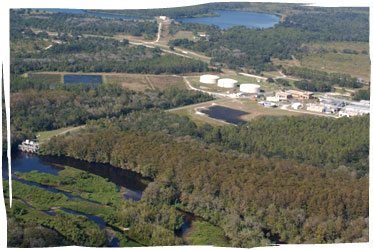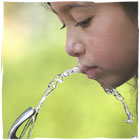Drinking Water

The Peace River/Manasota Regional Water Supply Authority provides water to more than 750,000 people. This main treatment facility on the Peace River near Ft. Ogden withdraws water during “wet” months, then stores it during the drier periods.
Phosphate mining and safe, adequate supplies of drinking water are not compatible uses of the environment. Today, more than 150,000 people depend on the Peace River for their drinking water supplies. Those supplies come from the same watershed that is being targeted for strip mining.
This is where the Peace River Manasota Water Supply Authority takes water from the Peace River. That water serves Charlotte, Sarasota and other communities and interests.
Phosphate impacts drinking water in many ways. First, the quantity of water is dwindling as water flows from the rivers decrease steadily. The Peace River Cumulative Impact Study suggests that phosphate mining is responsible for a significant portion of the flow reduction in some sections of the Peace River as well as reduced levels in the water table.
Quality of water is also an issue. Mining redistributes phosphate, metals, salts, lead, and radiological material formerly bound in the phosphate ore. In higher concentrations and released into the environment, these become poison and degrade water quality.
Old mine as reservoir
In the last 10 years, phosphate companies and others have suggested that some of those old mine cuts could become water reservoirs. "Why not use the land that's already been used," they argue. "That land has already been excavated and changed. Why dig up another place?"
Using old mines as potential water storage containers in Florida is complicated both technically and politically.

While there may be some benefit in having a reservoir that can release water downstream-for environmental or drinking purposes-where are we going to get the water to fill it? In Tampa Bay, they plan to fill their reservoir when the river is high during the rainy season. But can we afford to take more water from the river? And, if we allow expanded strip mining, how will water flows be affected for the long haul?
There are a number of technical issues also involved here. A settling pond is supposed to last 20 to 30 years; a reservoir has to last 100 or more. The mining companies would have to change the way they work to make a mine into a reservoir and make it cost effective. There's also an issue of what's below ground. Mining companies dig deep enough to harvest the phosphate mineral and then move on. Water suppliers have to take a hard, deep and detailed look at the geology. They can't afford to have a sinkhole open up under the reservoir. That would be bad, but worse would be a sinkhole under a holding wall. Downstream communities, in a very real sense, are at risk if that happens. Water suppliers can't afford to let it happen.
Even if a reservoir were environmentally and technically feasible, the project must also prove to be cost-effective. Construction costs, environmental controls and measures leading up to a decision must all be considered.
Finally, Florida law must be changed if mined lands are to become reservoirs. Of course, the phosphate companies are already trying to get their plan in place before studies or legislative changes can be made.
Once again, there are many unanswered questions. Yet the mining companies would like nothing better than to transfer their old mines to public management.